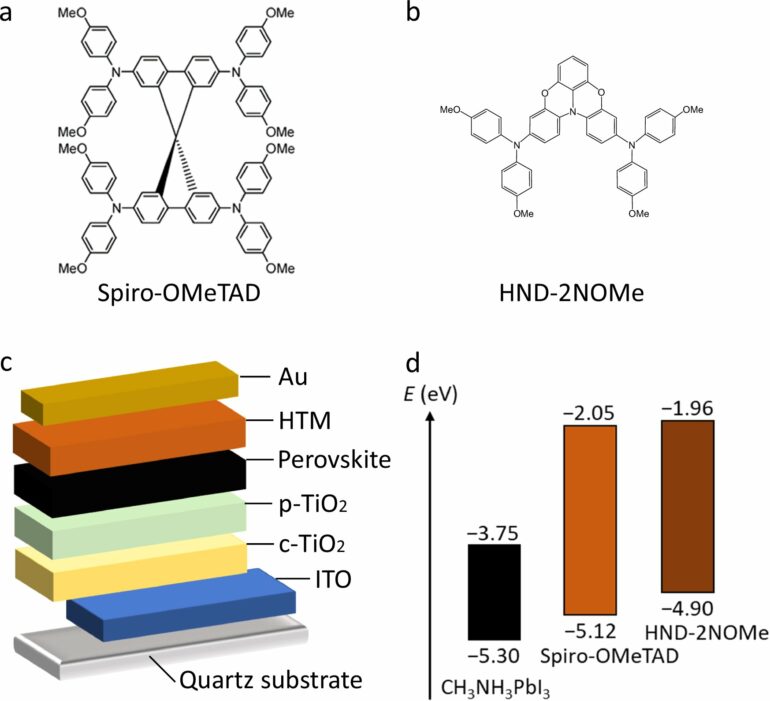Researchers at University of Tsukuba have investigated the internal properties of low-cost materials used in perovskite solar cells, which are attracting attention for their high efficiency, using electron spin resonance (ESR) to analyze these materials at a microscopic level.
The results clarify the underlying causes for reduced device performance, despite high local charge mobility, offering critical insights for designing improved solar cells. The study is published in Communications Materials.
Perovskite solar cells are a promising next-generation solar technology owing to their highly efficient light-to-electricity conversion. However, 2,2,’7,7′-tetrakis(N,N-di-p-methoxyphenylamine)-9,9′-spirobifluorene (spiro-OMeTAD)—a common hole-transport material—has limitations, such as complex synthesis and high cost.
To address these challenges, the researchers developed N3,N3,N11,N11-tetrakis(4-methoxyphenyl)[1,4]benzoxazino[2,3,4-kl]phenoxazine-3,11-diamine (HND-2NOMe), a cost-effective, easy to synthesize hole-transport material.
HND-2NOMe molecules possess a quasi-planar structure that allows them to align in a one-dimensional overlapping manner and thereby facilitates charge transfer. Despite demonstrating high charge mobility, perovskite solar cells incorporating HND-2NOMe have shown performance limitations, such as reduced current, the cause of which is still unknown.
Researchers at University of Tsukuba employed ESR to investigate the underlying mechanisms for the performance limitations of perovskite solar cells incorporating HND-2NOMe, focusing on the material’s internal properties at a microscopic scale.
They discovered that in the absence of illumination, holes migrate from perovskite to HND-2NOMe, forming an energetic barrier at the perovskite/HND-2NOMe interface. This barrier impedes hole flow, leading to performance limitations. Furthermore, solar cells incorporating HND-2NOMe demonstrate reduced hole accumulation under solar irradiation, which contributes to the stability of the hole transport function.
Identifying the factors responsible for performance limitations while maintaining stable functionality represents a substantial breakthrough with important implications for formulating fabrication guidelines aimed at enhancing device performance. Furthermore, the aforementioned findings will serve as a valuable foundation for advancing future research and development in perovskite solar cell technologies.
More information:
Xiangtao Zou et al, Microscopic analysis of low but stable perovskite solar cell device performance using electron spin resonance, Communications Materials (2024). DOI: 10.1038/s43246-024-00675-1
Provided by
University of Tsukuba
Citation:
Microscopic analysis clarifies performance limitations in cost-effective materials for perovskite solar cells (2024, November 5)



